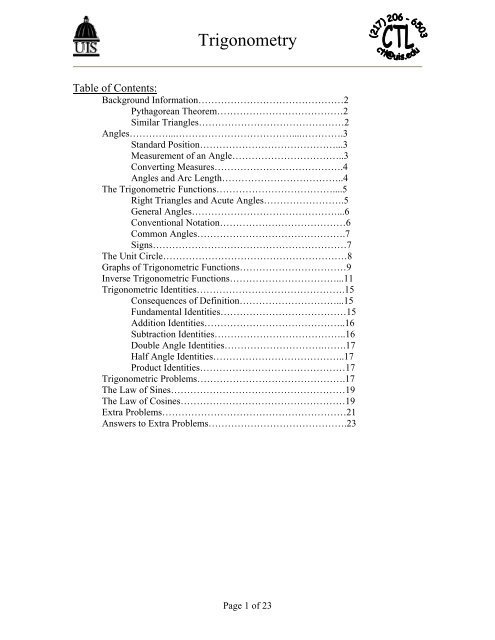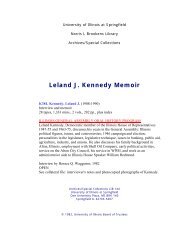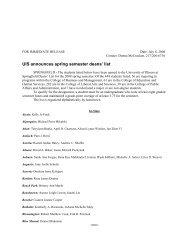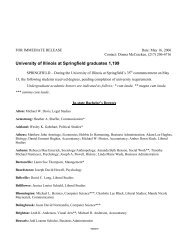Trigonometry Handout
Trigonometry Handout
Trigonometry Handout
Create successful ePaper yourself
Turn your PDF publications into a flip-book with our unique Google optimized e-Paper software.
<strong>Trigonometry</strong><br />
Table of Contents:<br />
Background Information………………………………………2<br />
Pythagorean Theorem…………………………………2<br />
Similar Triangles………………………………………2<br />
Angles…………...………………………………....………….3<br />
Standard Position……………………………………...3<br />
Measurement of an Angle……………………………..3<br />
Converting Measures………………………………….4<br />
Angles and Arc Length………………………………..4<br />
The Trigonometric Functions………………………………....5<br />
Right Triangles and Acute Angles…………………….5<br />
General Angles………………………………………...6<br />
Conventional Notation…………………………………6<br />
Common Angles……………………………………….7<br />
Signs……………………………………………………7<br />
The Unit Circle…………………………………………………8<br />
Graphs of Trigonometric Functions……………………………9<br />
Inverse Trigonometric Functions……………………………...11<br />
Trigonometric Identities……………………………………….15<br />
Consequences of Definition…………………………...15<br />
Fundamental Identities…………………………………15<br />
Addition Identities……………………………………..16<br />
Subtraction Identities…………………………………..16<br />
Double Angle Identities………………………….…….17<br />
Half Angle Identities…………………………………..17<br />
Product Identities………………………………………17<br />
Trigonometric Problems……………………………………….17<br />
The Law of Sines………………………………………………19<br />
The Law of Cosines……………………………………………19<br />
Extra Problems…………………………………………………21<br />
Answers to Extra Problems…………………………………….23<br />
Page 1 of 23
<strong>Trigonometry</strong><br />
<strong>Trigonometry</strong> is the study of how the sides and angles of a triangle relate to each other.<br />
Background Information:<br />
1) The Pythagorean Theorem:<br />
Let Δ ABC be a right triangle (See Figure 1)<br />
B<br />
Let the length of AB = c (hypotenuse)<br />
Let the length of BC = a (leg)<br />
c<br />
a<br />
Let the length of AC = b (leg)<br />
C<br />
b<br />
Figure 1<br />
A<br />
2<br />
2<br />
2<br />
Then a + b = c . In other words, the sum of the squares of the legs of a right triangle<br />
equals the square of the hypotenuse.<br />
2) Similar Triangles<br />
Definition: Two triangles are similar if corresponding angles are congruent (of equal<br />
measure).<br />
For a triangle, it is enough for two corresponding angles to be congruent, because<br />
that would force the third set to be congruent.<br />
It is also enough for the corresponding sides to be proportional:<br />
a<br />
B<br />
b<br />
d<br />
E<br />
e<br />
Figure 2<br />
A<br />
c<br />
C<br />
D<br />
f<br />
F<br />
If<br />
Δ ABC is similar to Δ DEF , then ∠ A ≅ ∠D, ∠B<br />
≅ ∠E,<br />
∠C<br />
≅ ∠F<br />
and<br />
a<br />
d<br />
=<br />
b<br />
e<br />
=<br />
c<br />
f<br />
From this, we also obtain that the ratio of any two sides of one triangle is equal to the<br />
ratio of the corresponding sides of the similar triangle.<br />
a d<br />
For example: =<br />
b e<br />
Page 2 of 23
<strong>Trigonometry</strong><br />
Angles:<br />
1) Standard Position:<br />
Angle<br />
Terminal Side<br />
Figure 3<br />
Vertex<br />
Initial Side<br />
The Standard Position of an angle occurs when the vertex of the angle is placed at the<br />
origin of a coordinate system and its initial side is on the positive x-axis.<br />
Angles in<br />
Standard Position<br />
θ<br />
θ<br />
Figure 4 Figure 5<br />
- A positive angle is obtained by rotating the initial side counterclockwise until it<br />
coincides with the terminal side (Figure 4).<br />
- A negative angle is obtained by rotating the initial side clockwise until it coincides with<br />
the terminal side (Figure 5).<br />
2) Measurement of Angles:<br />
Angles can be measured in degrees or radians (abbreviated rad).<br />
A complete revolution is 360 or 2 π rad.<br />
o<br />
Thus: π rad = 180<br />
o<br />
o<br />
⎛180<br />
⎞ o o π<br />
⇒ 1 rad = ⎜ ⎟ ≈ 57.3 or 1 = rad ≅ 0. 017<br />
⎝ π ⎠<br />
180<br />
rad<br />
Page 3 of 23
<strong>Trigonometry</strong><br />
3) Converting from degrees to radians and from radians to degrees<br />
Example 1:<br />
o<br />
a) Find the radian measure of 90<br />
o ⎛ π ⎞<br />
o π<br />
Solution: 90( 1 ) = 90⎜<br />
⎟rad<br />
⇒ 90 = rad<br />
⎝180<br />
⎠<br />
2<br />
7π<br />
b) Express rad<br />
6<br />
in degrees<br />
7π<br />
1<br />
6<br />
Solution: ( )<br />
o<br />
rad<br />
o<br />
7π<br />
⎛180<br />
⎞ 7π<br />
= ⎜ ⎟ ⇒ rad = 210<br />
6 ⎝ π ⎠ 6<br />
The following table gives some conversions between radians and degrees of some<br />
common angles:<br />
Degrees 0 30 45 60 90 120 135 150 180 270 360<br />
Radians 0 π π π π 2π 3π 5π π 3π 2π<br />
6 4 3 2 3 4 6 2<br />
Figure 6 shows some angles in standard position:<br />
θ<br />
θ<br />
θ<br />
θ<br />
π<br />
θ =<br />
4<br />
θ = −<br />
7π<br />
4<br />
Figure 6<br />
9π<br />
θ =<br />
4<br />
5π<br />
θ = −<br />
4<br />
4) Angles and Arc Length:<br />
Let O be a circle with radius r (Figure 7)<br />
Let θ be a central angle.<br />
r<br />
Let a be the length of the arc subtended by θ<br />
a<br />
O θ<br />
Figure 7<br />
Page 4 of 23
<strong>Trigonometry</strong><br />
The length of the arc is proportional to the measure of the angle and since the entire circle<br />
a θ<br />
has circumference 2 πr<br />
and central angle measure 2π<br />
⇒ =<br />
2π r 2π<br />
a a<br />
⇒ a = rθ , r = , θ =<br />
θ r<br />
Note: These are only valid when θ is measured in radians.<br />
Example 2:<br />
a) If the radius of a circle is 7 cm, what angle is subtended by an arc of 21 cm?<br />
a 21<br />
Solution: θ = = = 3 rad<br />
r 7<br />
b) A circle has a radius of 4 cm. What is the length of the arc subtended by an<br />
o<br />
angle of 90 ?<br />
o π<br />
Solution: Step 1: Angle must be in radians 90 = rad<br />
2<br />
π<br />
Step 2: a = rθ = 4 ⋅ = 2π<br />
cm<br />
2<br />
The Trigonometric Functions:<br />
1) Right Triangles and Acute Angles<br />
⎛ π ⎞<br />
Let θ be an acute angle ⎜0<br />
≤ θ < ⎟<br />
⎝ 2 ⎠<br />
hypotenuse The trigonometric functions are defined as ratios of<br />
opposite<br />
lengths of sides of a right triangle<br />
θ<br />
adjacent<br />
Note: Any right triangle with angle θ is similar to any other right triangle with angle θ .<br />
Since the ratios of sides in similar triangles are equal, then the trig functions will remain<br />
the same regardless of the lengths of the sides.<br />
sinθ<br />
=<br />
cosθ<br />
=<br />
opp<br />
hyp<br />
adj<br />
hyp<br />
cscθ<br />
=<br />
secθ<br />
=<br />
hyp<br />
opp<br />
hyp<br />
adj<br />
A tool to remember SOHCAHTOA<br />
tanθ<br />
=<br />
opp<br />
adj<br />
cotθ<br />
=<br />
adj<br />
opp<br />
π<br />
NOTE: These ratios only apply if 0 ≤ θ < .<br />
2<br />
Page 5 of 23
<strong>Trigonometry</strong><br />
2) General Angles<br />
Let θ be any angle in standard position<br />
Let P ( x,<br />
y)<br />
be any point on the terminal side of θ<br />
Let r be the distance from the origin to P (See Figure 9)<br />
P ( x,<br />
y)<br />
Then,<br />
sinθ<br />
=<br />
y<br />
r<br />
cscθ<br />
=<br />
r<br />
y<br />
r<br />
θ<br />
cosθ<br />
=<br />
x<br />
r<br />
secθ<br />
=<br />
r<br />
x<br />
O<br />
Figure 9<br />
tanθ<br />
=<br />
y<br />
x<br />
cotθ<br />
=<br />
x<br />
y<br />
Note: If y=0, then csc θ and cot θ are not defined. If x=0, then tan θ and sec θ are not<br />
defined. These definitions are consistent with the previous definition if θ is an acute<br />
angle.<br />
3) Conventional Notation<br />
If θ is a number, then by convention<br />
of the angle whose radian measure is θ .<br />
≈ where as sin( 5 ) ≈ 0. 0876<br />
So, sin5<br />
−9.<br />
589<br />
o<br />
sin θ (or any trig function) means the sine<br />
When using your calculator to compute trigonometric functions, you need to make sure<br />
that your calculator is set to the correct mode. If you are computing radian measures, you<br />
need to have your calculator in radians, and in degrees if you are computing degree<br />
measures.<br />
4) Some Common Angles:<br />
Here is a table of common angles and the trig functions computed at them.<br />
θ 0<br />
sin θ 0<br />
cos θ 1<br />
tan θ 0<br />
π<br />
6<br />
π<br />
4<br />
π<br />
3<br />
π<br />
2<br />
1<br />
3<br />
2 22<br />
2<br />
1<br />
1<br />
23<br />
22<br />
2<br />
0<br />
3 1 3 Und.<br />
3<br />
Page 6 of 23
<strong>Trigonometry</strong><br />
5) Signs<br />
The signs of the trig functions for angles in each quadrant can be remembered by<br />
the following saying:<br />
All Students Take Calculus<br />
Quad I: All ratios are positive<br />
S<br />
A<br />
Quad II: Sine and cosecant are positive<br />
Rest are negative<br />
Quad III: Tangent and cotangent are positive<br />
Rest are negative<br />
T<br />
C<br />
Quad IV: Cosine and secant are positive<br />
Rest are negative<br />
Figure 10<br />
3π<br />
Example 3: Let P = (−1,1 ) be a point on the terminal side of the angle θ = . Find the<br />
4<br />
exact trigonometric ratios for θ .<br />
Solution: Since P = (−1,1 ) is a point on the terminal side of the angle<br />
2 2<br />
( −1)<br />
+ (1) = 2 ⇒ r = 2<br />
1<br />
-1<br />
P<br />
θ<br />
sinθ<br />
=<br />
1<br />
2<br />
=<br />
2<br />
2<br />
cscθ<br />
=<br />
2<br />
1<br />
=<br />
2<br />
cosθ<br />
=<br />
−1<br />
2<br />
=<br />
−<br />
2<br />
2<br />
secθ<br />
=<br />
2<br />
−1<br />
= −<br />
2<br />
tanθ<br />
=<br />
1<br />
−1<br />
= −1<br />
−1<br />
cotθ<br />
= = −1<br />
1<br />
Page 7 of 23
<strong>Trigonometry</strong><br />
π<br />
Note: You could have also formed the right triangle with θ = and made the appropriate<br />
4<br />
sign changes for the quadrant you were in.<br />
Example 4: Let sin − 5<br />
3π<br />
θ = where π < θ < . Find the values of the other trigonometric<br />
6<br />
2<br />
functions.<br />
Solution:<br />
5<br />
6<br />
x =<br />
11<br />
θ<br />
We know that θ is in the 3 rd Quadrant.<br />
Thus, only tangent and cotangent have<br />
positive signs. Every thing else will be<br />
negative. For now we will just drop the<br />
signs to form a right triangle with hyp = 6<br />
and opp = 5 since sine is -5/6<br />
By the Pythagorean Theorem, we know that<br />
2 2 2 2<br />
2<br />
x + 5 = 6 ⇒ x + 25 = 36 ⇒ x = 11 ⇒ x =<br />
11<br />
So, we get the following ratios for the other 5 trig functions<br />
11 5<br />
6<br />
6<br />
cos θ = − tanθ<br />
= cscθ<br />
= − secθ<br />
= − cotθ<br />
=<br />
6<br />
11 5<br />
11<br />
11<br />
5<br />
The Unit Circle:<br />
The unit circle is a circle centered at the origin with radius 1, hence the name unit<br />
circle. It allows us to easily find the values of sine and cosine, and thus the rest of the<br />
trigonometric functions quickly and easily. There is a picture of the unit circle on the<br />
following page (Figure 11). The x-coordinates are the values of cosine and the y-<br />
coordinates are the values of sine.<br />
Page 8 of 23
<strong>Trigonometry</strong><br />
Figure 11: The Unit Circle<br />
Graphs of the Trigonometric Functions:<br />
1) f ( x)<br />
= sin x<br />
Domain of f: All real numbers<br />
x-intercepts: Let y = 0 , sin x = 0 ⇒ x = nπ<br />
where n is an integer.<br />
y-intercept: Let x = 0 , sin 0 = 0<br />
π<br />
−<br />
2<br />
π<br />
2<br />
Figure 12:<br />
f ( x)<br />
= sin x<br />
Page 9 of 23
<strong>Trigonometry</strong><br />
Range of f: −1 ≤ sin x ≤ 1<br />
The function is odd (symmetric with respect to the origin)<br />
The period is 2 π<br />
2) f ( x)<br />
= cos x<br />
Domain of f: All real numbers<br />
nπ<br />
x-intercepts: Let y = 0 , cos x = 0 ⇒ x = where n is an odd integer<br />
2<br />
y-intercept: Let x = 0 , cos 0 = 1<br />
π<br />
−<br />
2<br />
π<br />
2<br />
Figure 13: f ( x)<br />
= cos x<br />
Range of f: −1 ≤ cos x ≤ 1<br />
The function is even (symmetric with respect to y-axis)<br />
The period is 2 π<br />
The graphs of the remaining trigonometric functions are as follows. It is left to the reader<br />
to determine the characteristics of the graphs. (x-scale is 2 π units)<br />
Figure 14:<br />
f ( x)<br />
= tan x<br />
Figure 15:<br />
f ( x)<br />
= csc x<br />
Figure 16: f ( x)<br />
= sec x<br />
Page 10 of 23
<strong>Trigonometry</strong><br />
Figure 17:<br />
f ( x)<br />
= cot x<br />
Inverse Trigonometric Functions<br />
The trigonometric functions allow us to find the ratio of sides of a triangle if we<br />
know a given angle. What happens if we know the ratio and want to find the angle?<br />
1<br />
For instance, we know that sin θ = and we want to find θ<br />
2<br />
This is similar to when you want to know the value of x when x<br />
2 = 5 . In that<br />
case, you use an inverse function – namely, the square root function – which undoes the<br />
operation of the squaring function. In the same way we want to build an inverse<br />
trigonometric function which undoes the operation of the trigonometric function.<br />
Now, in order for a function to have an inverse function, the original function<br />
must pass the Horizontal Line Test. This means that any horizontal line drawn intersects<br />
the graph in at most one place. This is a problem for the trigonometric functions since<br />
they are periodic. In order to get inverse functions, we must restrict our domains so that<br />
we are able to define a unique inverse.<br />
We must meet the following criteria for the trig functions to have an inverse<br />
function:<br />
1. Each value of the range is taken on only once so that we can pass the<br />
horizontal line test.<br />
2. The range of the function with its restricted domain is the same as the range of<br />
the original function.<br />
π<br />
3. The domain includes the most commonly used numbers (or angles) 0 < x <<br />
2<br />
1) Inverse Sine<br />
The range of sine is −1 ≤ y ≤ 1, so this will become the domain of our inverse<br />
sine function. Now we need to find our restricted domain. If we look at the graph of<br />
sine, we see that the range is satisfied and we pass the horizontal line test if we take only<br />
π π<br />
the values − ≤ x ≤ . This will become the range of our inverse sine function.<br />
2 2<br />
We now define our inverse sine function as follows:<br />
−1<br />
If −1 ≤ x ≤ 1, then f ( x)<br />
= sin x = arcsin x if and only if sin f ( x)<br />
= x<br />
π<br />
π<br />
and − ≤ f ( x)<br />
≤ .<br />
2 2<br />
Page 11 of 23
<strong>Trigonometry</strong><br />
π<br />
2<br />
Figure 18:<br />
f ( x)<br />
= sin<br />
−1<br />
x<br />
2) Inverse Cosine<br />
−1<br />
If −1 ≤ x ≤ 1, then f ( x)<br />
= cos x = arccos x<br />
0 ≤ f ( x)<br />
≤ π .<br />
if and only if<br />
cos f ( x)<br />
= x and<br />
π<br />
2<br />
Figure 19:<br />
f ( x)<br />
= cos<br />
−1<br />
x<br />
3) Inverse Tangent<br />
If x is any real number, then<br />
π<br />
π<br />
and − ≤ f ( x)<br />
≤ .<br />
2 2<br />
f ( x)<br />
= tan<br />
−1<br />
x = arctan x<br />
if and only if<br />
tan f ( x)<br />
= x<br />
π<br />
2<br />
Figure 20:<br />
f ( x)<br />
= tan<br />
−1<br />
x<br />
Page 12 of 23
<strong>Trigonometry</strong><br />
4) Inverse Cosecant<br />
If x ≥ 1 , then =<br />
− 1<br />
f ( x)<br />
csc x = arc csc x if and only if csc f ( x)<br />
= x and<br />
−<br />
f , f ( x)<br />
≠ 0<br />
π<br />
≤ ( x)<br />
≤<br />
π<br />
2 2<br />
π<br />
2<br />
Figure 21:<br />
f ( x)<br />
= csc<br />
−1<br />
x<br />
5) Inverse Secant<br />
If x ≥ 1 , then =<br />
− 1<br />
f ( x)<br />
sec x = arcsec x if and only if sec f ( x)<br />
= x and<br />
0 ≤ f ( x)<br />
≤ π , f x)<br />
≠<br />
2<br />
(<br />
π<br />
π<br />
2<br />
Figure 22:<br />
f ( x)<br />
= sec<br />
−1<br />
x<br />
6) Inverse Cotangent<br />
If x is any real number, then =<br />
− 1<br />
f ( x)<br />
cot x = arccot x if and only if cot f ( x)<br />
= x<br />
and 0 < f ( x)<br />
< π<br />
π<br />
2<br />
Figure 23:<br />
f ( x)<br />
= cot<br />
−1<br />
x<br />
Page 13 of 23
<strong>Trigonometry</strong><br />
Now, back to our problem, If<br />
1<br />
sin θ = , then what is θ ?<br />
2<br />
One way to come up with the solution is to look at the unit circle and find out<br />
which points have a y-coordinate of 1 π<br />
2<br />
. You will see that this occurs when θ = and<br />
6<br />
5π<br />
when θ = . Since sine is periodic, we know that we have infinite solutions to our<br />
6<br />
problem, namely θ = π + 2 nπ<br />
and θ 5 π<br />
= + 2n<br />
π .<br />
6 6<br />
1<br />
Now, say instead that we wanted to find (<br />
1<br />
sin − )<br />
. This will only give us one answer, but<br />
2<br />
1<br />
which one will it be? Well, by our restrictions, we need to find θ such that sin θ = and<br />
2<br />
π π<br />
−1<br />
− ≤ θ ≤ . Looking at all of our possible solutions, only one works, (<br />
1<br />
)<br />
π<br />
θ = sin =<br />
2 2<br />
2 6<br />
In general, there are infinitely many solutions to problems where you know the value of<br />
the trigonometric function but not the angle. Using inverse trigonometric functions gives<br />
us what is called the principal value of the relation. The principal value of the relation is<br />
the angle that is a solution to the problem and that has the smallest absolute value. If<br />
positive and negative values both satisfy, then we use the positive angle.<br />
Example: Find tan −1<br />
1<br />
π π<br />
Solution: We want to find x such that tan x = 1 and − ≤ x ≤ . If we use the<br />
2 2<br />
5<br />
unit circle, tan x = 1 when cos x = sin x , which occurs when x =<br />
π , π . Only one of these<br />
4 4<br />
−<br />
values is in our interval, so 1 π<br />
tan 1 = .<br />
4<br />
.<br />
Trigonometric Identities:<br />
1) Consequences of the Definitions<br />
1<br />
1<br />
1) csc θ = 2) sec θ = 3)<br />
sinθ<br />
cosθ<br />
cot θ =<br />
1<br />
tanθ<br />
4)<br />
sinθ<br />
tan θ = 5)<br />
cosθ<br />
cosθ<br />
cot θ =<br />
sinθ<br />
2) Some fundamental identities<br />
2 2<br />
6) cos θ + sin θ = 1<br />
Proof: Refer back to Figure 9. The distance formula gives that<br />
2 2 2<br />
2 2 ⎛ x ⎞ ⎛ y ⎞ x y x + y r<br />
x + y = r . Thus, cos θ + sin θ = ⎜ ⎟ + ⎜ ⎟ = + = = = 1<br />
2 2 2 2<br />
⎝ r ⎠ ⎝ r ⎠ r r r r<br />
2<br />
2<br />
2<br />
2<br />
2<br />
2<br />
2<br />
Page 14 of 23
<strong>Trigonometry</strong><br />
2<br />
2<br />
7) tan θ + 1 = sec θ<br />
2 2<br />
Proof: Take sin θ + cos θ = 1 and divide by cos<br />
2 θ<br />
2<br />
2<br />
sin θ cos θ 1<br />
2<br />
2<br />
+ = ⇒ tan θ + 1 = sec θ<br />
2 2<br />
2<br />
cos θ cos θ cos θ<br />
2<br />
2<br />
8) 1 + cot θ = csc θ<br />
2 2<br />
Proof: Take sin θ + cos θ = 1 and divide by sin<br />
2 θ<br />
9a) sin( − θ ) = −sinθ<br />
(sine is an odd function)<br />
9b) cos( − θ ) = cosθ<br />
(cosine is an even function)<br />
Proof: You can refer to figures 12 and 13, or<br />
By definition:<br />
(x, y)<br />
y<br />
sinθ<br />
=<br />
r<br />
θ<br />
− y<br />
sin( −θ<br />
) = = −sinθ<br />
− θ<br />
r<br />
x<br />
cosθ<br />
=<br />
r<br />
(x, -y)<br />
cos( −θ<br />
) =<br />
10a) sin( θ + 2π<br />
) = sinθ<br />
10b) cos( θ + 2π<br />
) = cosθ<br />
True because θ + 2 π = θ<br />
This implies that sine and cosine are<br />
x<br />
r<br />
= cosθ<br />
2π<br />
− periodic<br />
3) Addition Formulas<br />
11a) sin( x + y)<br />
= sin xcos<br />
y + sin y cos x<br />
11b) cos( x + y)<br />
= cos xcos<br />
y − sin xsin<br />
y<br />
Proof: Refer to Figure 25<br />
B<br />
y<br />
l(<br />
OB)<br />
= 1<br />
l(<br />
AE)<br />
= d<br />
l(<br />
BA)<br />
= a<br />
l(<br />
DA)<br />
= c<br />
l(<br />
OC)<br />
= f<br />
l(<br />
DC)<br />
= d<br />
l(<br />
BD)<br />
= g<br />
l(<br />
OA)<br />
= b<br />
l(<br />
BC)<br />
= e<br />
l(<br />
CE)<br />
= c<br />
O<br />
x<br />
y<br />
D<br />
F<br />
A<br />
C<br />
E<br />
∠ OAD ∠AEC<br />
∠OCB<br />
∠BDC<br />
are right angles<br />
m∠AFO<br />
= 90 − y = m∠DFC<br />
m∠DBC<br />
= 90 − m∠DFC<br />
= 90 − (90 − y)<br />
=<br />
y<br />
Figure 25(Not to Scale)<br />
Page 15 of 23
<strong>Trigonometry</strong><br />
From<br />
From<br />
From<br />
From<br />
Δ AOB , we get that sin( x + y)<br />
= a and cos( x + y)<br />
= b<br />
Δ OCB , we get that sin x = e and cos x = f<br />
c<br />
Δ OCE , we get that sin y = ⇒ c = cos xsin<br />
y and<br />
f<br />
b + d<br />
cos y = ⇒ d = cos x cos y − cos( x + y)<br />
f<br />
d<br />
g<br />
Δ BDC , we get that sin y = ⇒ d = sin xsin<br />
y and cos y = ⇒ g = cos y sin x<br />
e<br />
e<br />
Putting everything together, we get that<br />
d = sin xsin<br />
y = cos x cos y − cos( x + y)<br />
⇒ cos( x + y)<br />
= cos x cos y − sin xsin<br />
y<br />
And<br />
Since a = g + c , then sin( x + y)<br />
= sin x cos y + sin y cos x<br />
4) Subtraction Formulas<br />
12a) sin( x − y)<br />
= sin x cos y − sin y cos x<br />
12b) cos( x − y)<br />
= cos x cos y + sin xsin<br />
y<br />
Proof: Replace y by –y in Addition Formulas.<br />
5) Addition and Subtraction with Tangent<br />
tan x + tan y<br />
13a) tan( x + y)<br />
=<br />
1−<br />
tan x tan y<br />
tan x − tan y<br />
13b) tan( x − y)<br />
=<br />
1+<br />
tan x tan y<br />
sin( x + y)<br />
sin x cos y + cos xsin<br />
y<br />
Proof of 13a: =<br />
Left-hand side is<br />
cos( x + y)<br />
cos x cos y − sin xsin<br />
y<br />
tan( x + y) . Divide the top and bottom of the right-hand side by cos x cos y to get<br />
sin x cos y cos xsin<br />
y<br />
+<br />
cos x cos y cos x cos y tan x + tan y<br />
tan( x + y)<br />
=<br />
=<br />
cos x cos y sin xsin<br />
y 1−<br />
tan x tan y<br />
−<br />
cos x cos y cos x cos y<br />
6) Double Angle Formulas<br />
14a) sin 2x<br />
= 2sin x cos x<br />
2 2<br />
14b) cos2x<br />
= cos x − sin x<br />
Proof of 14a) sin 2x<br />
= sin( x + x)<br />
= sin x cos x + sin x cos x = 2sin x cos x<br />
Page 16 of 23
<strong>Trigonometry</strong><br />
7) Alternate forms of Double Angle Formulas for Cosine<br />
2<br />
15a) cos2x<br />
= 2cos x −1<br />
2<br />
15b) cos2x<br />
= 1−<br />
2sin x<br />
2 2<br />
Proof of 15a: Use sin θ + cos θ = 1<br />
2 2 2<br />
2<br />
2<br />
cos2x<br />
= cos x − sin x = cos x − (1 − cos x)<br />
= 2cos x −1<br />
8) Half Angle Formulas<br />
1 cos2<br />
16a) cos 2 + x<br />
x =<br />
2<br />
1 cos2<br />
16b) sin 2 − x<br />
x =<br />
2<br />
Proof of 16a:<br />
cos2x<br />
= 2cos<br />
cos2x<br />
+ 1 = 2cos<br />
cos<br />
2<br />
2<br />
x −1<br />
2<br />
1+<br />
cos2x<br />
x =<br />
2<br />
9) Product Formulas<br />
17a) sin x cos y =<br />
1 [ sin( x + y)<br />
+ sin( x − y )]<br />
2<br />
17b) cos x cos y =<br />
1 [ cos( x + y)<br />
+ cos( x − y )]<br />
2<br />
17c) sin x sin y =<br />
1 [ cos( x − y)<br />
− cos( x + y )]<br />
2<br />
Proof of 17a:<br />
1<br />
1<br />
sin( x + y)<br />
+ sin( x − y)<br />
= sin xcos<br />
y + sin y cos x + sin x cos y − sin y cos x<br />
2<br />
2<br />
1<br />
= 2sin xcos<br />
y = sin xcos<br />
x<br />
[ ] [ ]<br />
[ ] y<br />
2<br />
Trigonometric Problems<br />
Example 5: Find all values of x in the interval [ 0 ,2π ] such that cos x = cos2x<br />
.<br />
2<br />
2<br />
Solution: We know that, cos2x = 2cos x −1, so we get cos x = 2cos x −1<br />
2<br />
⇒ 2cos x − cos x −1<br />
= 0<br />
Let u = cos x<br />
2<br />
⇒ 2u<br />
− u −1<br />
= 0<br />
⇒ (2u<br />
+ 1)( u −1)<br />
= 0<br />
⇒ u = −<br />
1<br />
2<br />
⇒ cos x = −<br />
⇒ x =<br />
u = 1<br />
cos x = 1<br />
1<br />
2<br />
2π 4π<br />
x =<br />
3 3<br />
x = 0 x = 2<br />
π<br />
Page 17 of 23
<strong>Trigonometry</strong><br />
Example 6: Find the period of the function y = 17 sin(9t<br />
+ 21)<br />
Solution: We know that the period of sine is 2 π . sin(bt ) is going through the<br />
radians b times faster, so the values of sin(bt ) repeat b times sooner, or in b1<br />
th the time.<br />
This gives us that the period is 2 π<br />
. For )<br />
b<br />
sin( bt + c , the c does not change how quickly<br />
we go through the radians, it just affects where we start, so it has no impact on the period<br />
(It produces a horizontal shift, so it just moves the entire graph right or left, but does not<br />
change the shape, which would change the period). Thus the period of<br />
y = 17 sin(9t<br />
+ 21) is 2π 9<br />
.<br />
Example 7: The wheels of a bicycle have radius 55 cm and are rotating at 60 rpm. Find<br />
the speed of the bicycle in km/hour. Round your answer to the nearest tenth.<br />
Solution: In one minute, the angle changes by 60 ⋅ 2π = 120π<br />
radians<br />
In one hour, the angle changes by 60 ⋅ 120π = 7200π<br />
radians<br />
Hence, the linear speed in cm/hr is 55⋅ 7200π<br />
55⋅7200π<br />
So in km/hr we get ≈ 12. 4 km/hr<br />
100,000<br />
Example 8: The angle of elevation of tree 230 feet away is 12 degrees. Find the number<br />
of feet in the height of the tree. Round to the nearest integer.<br />
Solution: If we look at this problem as a right triangle, then we are looking for the<br />
length of the side opposite the 12 degree angle. We know that the adjacent side is 230<br />
o x<br />
o<br />
feet. Thus, tan( 12 ) = ⇒ x = 230tan(12 ) ⇒ x ≈ 49 feet tall.<br />
230<br />
1 1<br />
Example 9: The trigonometric function<br />
−<br />
is equal to which of the<br />
1−<br />
cos(7x ) 1+<br />
cos(7x)<br />
following?<br />
a) 2csc(7x )cot(7x)<br />
b) 2sec(7x )cot(7x)<br />
c) 2cot(14x )csc(7x)<br />
d) 2sec(7x<br />
csc(7x)<br />
Solution: We will start by getting a common denominator<br />
[ 1+<br />
cos(7x)<br />
] − [ 1−<br />
cos(7x)<br />
] 1+<br />
cos(7x)<br />
−1+<br />
cos(7x)<br />
2cos(7x)<br />
cos(7x)<br />
1<br />
=<br />
= = 2⋅<br />
⋅<br />
2 2<br />
[ 1−<br />
cos(7x)<br />
][ 1+<br />
cos(7x)<br />
] 1−<br />
cos (7x)<br />
sin (7x)<br />
sin(7x)<br />
sin(7x)<br />
= 2 cot(7x )csc(7x)<br />
= a<br />
5<br />
Example 10: If sin p = , cos = 12<br />
3<br />
4<br />
p , sin q = and cos = sin p + q .<br />
13<br />
13<br />
5<br />
5<br />
56<br />
Solution: sin( p + q)<br />
= sin p cosq<br />
+ sin qcos<br />
p =<br />
5 ⋅<br />
4 +<br />
3 ⋅<br />
12 =<br />
20 +<br />
36 =<br />
13 5 5 13 65 65 65<br />
q , find ( )<br />
Example 11: What are the solution(s) of sin 2 − 4sin x + 3 = 0<br />
− π ,π ?<br />
2<br />
Solution: Let u = sin x ⇒ u − 4u<br />
+ 3 = 0 ⇒ ( u − 3)( u −1)<br />
= 0 ⇒ u = 3, 1<br />
sin x = 3<br />
π<br />
⇒ ⇒ x = Note: sin x will never be 3 because the range of sine is −1 ≤ y ≤ 1<br />
2<br />
sin x = 1<br />
x in the interval ( )<br />
Page 18 of 23
<strong>Trigonometry</strong><br />
The Law of Sines<br />
In any triangle ABC with sides a, b, and c (as in Figure 26),<br />
a b c<br />
= =<br />
sin A sin B sinC<br />
Proof: B<br />
h<br />
From Δ ADB , sin A = ⇒ h = csin<br />
A<br />
c<br />
h<br />
a<br />
From Δ CDB , sin C = ⇒ h = asinC<br />
c h<br />
a<br />
Thus, csin A = asinC<br />
a c<br />
⇒ =<br />
A D b<br />
C sin A sinC<br />
Figure 26<br />
Other ratios can be found by constructing the perpendiculars from other vertices.<br />
The Law of Sines is used when we know more angles than sides.<br />
o<br />
Example 12: Solve Δ ABC if A = 32 , C = 81.8 , and a = 42. 9 cm<br />
Solution: We want to find the measure of angle B and the length of sides b and c.<br />
Step 1: We know two of the three angles. The sum of angles in a triangle<br />
o<br />
o o o o<br />
is 180 . So m ∠B = 180 − 32 − 81.8 = 66.2<br />
Step 2: We will use the Law of Sines to compute the sides.<br />
42.9 b 42.9 c<br />
= and =<br />
o<br />
o<br />
o<br />
o<br />
sin(32 ) sin(66.2 ) sin(32 ) sin(81.8 )<br />
With some computation, we find that b = 74. 1cm and c = 80. 1cm<br />
The Law of Cosines<br />
In any triangle ABC with sides a, b, and c,<br />
2 2 2<br />
a = b + c − 2bccos<br />
A<br />
2 2 2<br />
b = a + c − 2accos<br />
B<br />
2 2 2<br />
c = a + b − 2abcosC<br />
Proof: Let ( x , y)<br />
be the coordinates of A<br />
A<br />
y<br />
x<br />
sin B = and cos B =<br />
c<br />
c<br />
y<br />
b<br />
c<br />
⇒ y = csin<br />
B and x = ccos<br />
B<br />
⇒ A = ( ccos<br />
B,<br />
csin<br />
B)<br />
Also, C = (a,0 D ) and x l ( AC B ) = b . a By the distance C Formula,<br />
2<br />
2<br />
b = ( ccos<br />
B − a)<br />
+ ( csin<br />
B)<br />
Figure 27<br />
o<br />
Page 19 of 23
<strong>Trigonometry</strong><br />
By squaring both sides of the equation, we get<br />
2<br />
2<br />
2<br />
b = ( ccos<br />
B − a)<br />
+ ( csin<br />
B)<br />
2 2<br />
2 2 2<br />
= c cos B − 2accos<br />
B + a + c sin B<br />
2 2 2 2<br />
= a + c (cos B + sin B)<br />
− 2accos<br />
B<br />
2 2<br />
= a + c − 2accos<br />
B<br />
The other equations may be obtained by placing the other vertices at the origin.<br />
The Law of Cosines is used when we know more sides than angles.<br />
Example 13: A surveyor wishes to find the distance between two inaccessible points A<br />
and B on opposite sides of a lake. While standing at point C, she finds that l ( AC)<br />
= 259<br />
o<br />
meters, l ( BC)<br />
= 423 meters, and m ∠ACB = 125 . Find the distance from A to B. See<br />
Figure 28.<br />
Solution:<br />
The Law of Cosines can be used here since<br />
A<br />
we know the length of two sides and the<br />
measure of the included angle.<br />
B<br />
2 2 2<br />
o<br />
[ l ( AB)<br />
] = 259 + 423 − 2(259)(423)cos(125 )<br />
= 371688.63<br />
⇒ l( AB)<br />
= 609.66meters<br />
C<br />
Figure 28<br />
Page 20 of 23
<strong>Trigonometry</strong><br />
Extra Problems<br />
1. A circle has a radius of r cm. If θ = 3 rad, and the arc a = 33 cm, then what is the<br />
radius of the circle, r?<br />
2. The angle of elevation of a tree 219 feet away is 17 degrees. Find the number of feet<br />
in the height of the tree. Give your answer to the nearest integer.<br />
3. In a right triangle, a = 39 cm, b = 36 cm and c = 15 cm. Find cot θ .<br />
c<br />
a<br />
b<br />
4. Using the same right triangle from problem 3, but now with a = 37 cm, b = 35cm, and<br />
c = 12 cm, find sec θ .<br />
1 1<br />
5. The trigonometric function −<br />
1−<br />
sin(3x ) 1+<br />
sin(3x)<br />
is equal to which of the<br />
following:<br />
a) 2sec(3x )cot(3x)<br />
b) 2cot(6x )csc(3x)<br />
c) 2sec(3x<br />
)csc(3x)<br />
d) sec( 3x ) tan(3x)<br />
e) 2sec(3x<br />
) tan(3x)<br />
1+<br />
sin(6x)<br />
1−<br />
sin(6x)<br />
6. The trigonometric function − is equal to which of the<br />
1−<br />
sin(6x)<br />
1+<br />
sin(6x)<br />
following:<br />
a) 2sec(6x ) tan(6x)<br />
b) 4cot(12x )csc(6x)<br />
c) 4sec(6x<br />
)cot(6x)<br />
d) sec( 6x ) tan(6x)<br />
e) 4 tan(6x<br />
)sec(6x)<br />
8<br />
15<br />
5<br />
7. If sin p = , cos p = , sin q = , and cos q = 12 . Find sin( q − p)<br />
. Express your<br />
17<br />
17<br />
13<br />
13<br />
answer as a common fraction.<br />
8. Two straight railways cross each other at angle θ = 33 . Two trains A and B leave the<br />
intersection O at the same time. The velocity of train A is 29 mph and the velocity of<br />
train B is 57 mph. Find the distance between the two trains after 5 hours. Give your<br />
answer to the nearest integer. The picture is not drawn to scale.<br />
A<br />
θ<br />
o<br />
O<br />
θ<br />
B<br />
Page 21 of 23
<strong>Trigonometry</strong><br />
15<br />
9. If cos p = and sin p < 0. Find cot p<br />
17<br />
15<br />
10. If cos p = and sin p < 0. Find csc p<br />
17<br />
11. The period of the function y = 15sec(7t)<br />
is?<br />
12. The period of the function y = 13 cos(11t<br />
+ 15)<br />
is?<br />
13. The radius of the wheels of your car measure 27 cm. Suppose that each wheel is<br />
rotating at 964 rpm. Find the speed of your car in km/h. Round your answer to the<br />
nearest tenth.<br />
14. The rectangle below has a diagonal AC = 31cm. The angle θ = 27 . How many<br />
square centimeters are in the area of the rectangle. Picture not to scale.<br />
D<br />
C<br />
o<br />
A<br />
θ<br />
B<br />
5<br />
15. If sin p = , find sin( π − p)<br />
.<br />
7<br />
16. What are the solutions of 2sin + sin a −1<br />
= 0<br />
17. What are the solutions of 2sin b − 9sinb + 4 = 0 ?<br />
2<br />
2<br />
a in the interval ( 2π ,0)<br />
− ?<br />
18. Find<br />
−<br />
⎛ 3 ⎞<br />
sin 1 ⎜ ⎟<br />
−<br />
.<br />
⎝ 2 ⎠<br />
19. Find sec − 1 (2)<br />
.<br />
o<br />
20. Erin wishes to measure the distance across Eagle River. She find that C = 102 ,<br />
o<br />
A = 25 and b = 345 feet. Find the required distance. Round your answer to the nearest<br />
foot.<br />
A<br />
b<br />
B<br />
a<br />
C<br />
Page 22 of 23
<strong>Trigonometry</strong><br />
Answers to Extra Problems<br />
1. 11 cm<br />
2. 67 feet<br />
12<br />
3. cm<br />
5<br />
37<br />
4. 35<br />
cm<br />
5. e<br />
6. e<br />
39<br />
7. 221<br />
8. 181 miles<br />
15<br />
9. −<br />
8<br />
17<br />
10. −<br />
8<br />
11.<br />
2π<br />
7<br />
2π<br />
12.<br />
11<br />
13. 98.1 km/hr<br />
14. 388.73 square centimeters<br />
5<br />
15. 7<br />
16.<br />
11 π 7π<br />
a = − , − , −<br />
π<br />
6 6 2<br />
π 5π<br />
17. b = + 2nπ<br />
, + 2nπ<br />
6 6<br />
π<br />
18. −<br />
3<br />
π<br />
19.<br />
3<br />
20. 183 feet<br />
Page 23 of 23

















